Injectable Formulations
Oral Formulations
Topical Formulations
Transdermal Formulations
Cell and Gene Therapy
Binders
Disintegrants
Lubricants
Preservatives
Stabilizers
Functional Excipients
Multi-functional Excipients
Inert Excipients
Active Excipients
Pharmaceutical Companies
Contract Manufacturing Organizations
Research Institutes
North America
Europe
South America
Asia Pacific
Middle East and Africa
North America Outlook (USD Billion, 2019-2035)
North America Biopharmaceutical Excipients Market by Application Type
Injectable Formulations
Oral Formulations
Topical Formulations
Transdermal Formulations
Cell and Gene Therapy
North America Biopharmaceutical Excipients Market by Type
Binders
Disintegrants
Lubricants
Preservatives
Stabilizers
North America Biopharmaceutical Excipients Market by Functionality Type
Functional Excipients
Multi-functional Excipients
Inert Excipients
Active Excipients
North America Biopharmaceutical Excipients Market by End Use Type
Pharmaceutical Companies
Contract Manufacturing Organizations
Research Institutes
North America Biopharmaceutical Excipients Market by Regional Type
US
Canada
US Outlook (USD Billion, 2019-2035)
US Biopharmaceutical Excipients Market by Application Type
Injectable Formulations
Oral Formulations
Topical Formulations
Transdermal Formulations
Cell and Gene Therapy
US Biopharmaceutical Excipients Market by Type
Binders
Disintegrants
Lubricants
Preservatives
Stabilizers
US Biopharmaceutical Excipients Market by Functionality Type
Functional Excipients
Multi-functional Excipients
Inert Excipients
Active Excipients
US Biopharmaceutical Excipients Market by End Use Type
Pharmaceutical Companies
Contract Manufacturing Organizations
Research Institutes
CANADA Outlook (USD Billion, 2019-2035)
CANADA Biopharmaceutical Excipients Market by Application Type
Injectable Formulations
Oral Formulations
Topical Formulations
Transdermal Formulations
Cell and Gene Therapy
CANADA Biopharmaceutical Excipients Market by Type
Binders
Disintegrants
Lubricants
Preservatives
Stabilizers
CANADA Biopharmaceutical Excipients Market by Functionality Type
Functional Excipients
Multi-functional Excipients
Inert Excipients
Active Excipients
CANADA Biopharmaceutical Excipients Market by End Use Type
Pharmaceutical Companies
Contract Manufacturing Organizations
Research Institutes
Europe Outlook (USD Billion, 2019-2035)
Europe Biopharmaceutical Excipients Market by Application Type
Injectable Formulations
Oral Formulations
Topical Formulations
Transdermal Formulations
Cell and Gene Therapy
Europe Biopharmaceutical Excipients Market by Type
Binders
Disintegrants
Lubricants
Preservatives
Stabilizers
Europe Biopharmaceutical Excipients Market by Functionality Type
Functional Excipients
Multi-functional Excipients
Inert Excipients
Active Excipients
Europe Biopharmaceutical Excipients Market by End Use Type
Pharmaceutical Companies
Contract Manufacturing Organizations
Research Institutes
Europe Biopharmaceutical Excipients Market by Regional Type
Germany
UK
France
Russia
Italy
Spain
Rest of Europe
GERMANY Outlook (USD Billion, 2019-2035)
GERMANY Biopharmaceutical Excipients Market by Application Type
Injectable Formulations
Oral Formulations
Topical Formulations
Transdermal Formulations
Cell and Gene Therapy
GERMANY Biopharmaceutical Excipients Market by Type
Binders
Disintegrants
Lubricants
Preservatives
Stabilizers
GERMANY Biopharmaceutical Excipients Market by Functionality Type
Functional Excipients
Multi-functional Excipients
Inert Excipients
Active Excipients
GERMANY Biopharmaceutical Excipients Market by End Use Type
Pharmaceutical Companies
Contract Manufacturing Organizations
Research Institutes
UK Outlook (USD Billion, 2019-2035)
UK Biopharmaceutical Excipients Market by Application Type
Injectable Formulations
Oral Formulations
Topical Formulations
Transdermal Formulations
Cell and Gene Therapy
UK Biopharmaceutical Excipients Market by Type
Binders
Disintegrants
Lubricants
Preservatives
Stabilizers
UK Biopharmaceutical Excipients Market by Functionality Type
Functional Excipients
Multi-functional Excipients
Inert Excipients
Active Excipients
UK Biopharmaceutical Excipients Market by End Use Type
Pharmaceutical Companies
Contract Manufacturing Organizations
Research Institutes
FRANCE Outlook (USD Billion, 2019-2035)
FRANCE Biopharmaceutical Excipients Market by Application Type
Injectable Formulations
Oral Formulations
Topical Formulations
Transdermal Formulations
Cell and Gene Therapy
FRANCE Biopharmaceutical Excipients Market by Type
Binders
Disintegrants
Lubricants
Preservatives
Stabilizers
FRANCE Biopharmaceutical Excipients Market by Functionality Type
Functional Excipients
Multi-functional Excipients
Inert Excipients
Active Excipients
FRANCE Biopharmaceutical Excipients Market by End Use Type
Pharmaceutical Companies
Contract Manufacturing Organizations
Research Institutes
RUSSIA Outlook (USD Billion, 2019-2035)
RUSSIA Biopharmaceutical Excipients Market by Application Type
Injectable Formulations
Oral Formulations
Topical Formulations
Transdermal Formulations
Cell and Gene Therapy
RUSSIA Biopharmaceutical Excipients Market by Type
Binders
Disintegrants
Lubricants
Preservatives
Stabilizers
RUSSIA Biopharmaceutical Excipients Market by Functionality Type
Functional Excipients
Multi-functional Excipients
Inert Excipients
Active Excipients
RUSSIA Biopharmaceutical Excipients Market by End Use Type
Pharmaceutical Companies
Contract Manufacturing Organizations
Research Institutes
ITALY Outlook (USD Billion, 2019-2035)
ITALY Biopharmaceutical Excipients Market by Application Type
Injectable Formulations
Oral Formulations
Topical Formulations
Transdermal Formulations
Cell and Gene Therapy
ITALY Biopharmaceutical Excipients Market by Type
Binders
Disintegrants
Lubricants
Preservatives
Stabilizers
ITALY Biopharmaceutical Excipients Market by Functionality Type
Functional Excipients
Multi-functional Excipients
Inert Excipients
Active Excipients
ITALY Biopharmaceutical Excipients Market by End Use Type
Pharmaceutical Companies
Contract Manufacturing Organizations
Research Institutes
SPAIN Outlook (USD Billion, 2019-2035)
SPAIN Biopharmaceutical Excipients Market by Application Type
Injectable Formulations
Oral Formulations
Topical Formulations
Transdermal Formulations
Cell and Gene Therapy
SPAIN Biopharmaceutical Excipients Market by Type
Binders
Disintegrants
Lubricants
Preservatives
Stabilizers
SPAIN Biopharmaceutical Excipients Market by Functionality Type
Functional Excipients
Multi-functional Excipients
Inert Excipients
Active Excipients
SPAIN Biopharmaceutical Excipients Market by End Use Type
Pharmaceutical Companies
Contract Manufacturing Organizations
Research Institutes
REST OF EUROPE Outlook (USD Billion, 2019-2035)
REST OF EUROPE Biopharmaceutical Excipients Market by Application Type
Injectable Formulations
Oral Formulations
Topical Formulations
Transdermal Formulations
Cell and Gene Therapy
REST OF EUROPE Biopharmaceutical Excipients Market by Type
Binders
Disintegrants
Lubricants
Preservatives
Stabilizers
REST OF EUROPE Biopharmaceutical Excipients Market by Functionality Type
Functional Excipients
Multi-functional Excipients
Inert Excipients
Active Excipients
REST OF EUROPE Biopharmaceutical Excipients Market by End Use Type
Pharmaceutical Companies
Contract Manufacturing Organizations
Research Institutes
APAC Outlook (USD Billion, 2019-2035)
APAC Biopharmaceutical Excipients Market by Application Type
Injectable Formulations
Oral Formulations
Topical Formulations
Transdermal Formulations
Cell and Gene Therapy
APAC Biopharmaceutical Excipients Market by Type
Binders
Disintegrants
Lubricants
Preservatives
Stabilizers
APAC Biopharmaceutical Excipients Market by Functionality Type
Functional Excipients
Multi-functional Excipients
Inert Excipients
Active Excipients
APAC Biopharmaceutical Excipients Market by End Use Type
Pharmaceutical Companies
Contract Manufacturing Organizations
Research Institutes
APAC Biopharmaceutical Excipients Market by Regional Type
China
India
Japan
South Korea
Malaysia
Thailand
Indonesia
Rest of APAC
CHINA Outlook (USD Billion, 2019-2035)
CHINA Biopharmaceutical Excipients Market by Application Type
Injectable Formulations
Oral Formulations
Topical Formulations
Transdermal Formulations
Cell and Gene Therapy
CHINA Biopharmaceutical Excipients Market by Type
Binders
Disintegrants
Lubricants
Preservatives
Stabilizers
CHINA Biopharmaceutical Excipients Market by Functionality Type
Functional Excipients
Multi-functional Excipients
Inert Excipients
Active Excipients
CHINA Biopharmaceutical Excipients Market by End Use Type
Pharmaceutical Companies
Contract Manufacturing Organizations
Research Institutes
INDIA Outlook (USD Billion, 2019-2035)
INDIA Biopharmaceutical Excipients Market by Application Type
Injectable Formulations
Oral Formulations
Topical Formulations
Transdermal Formulations
Cell and Gene Therapy
INDIA Biopharmaceutical Excipients Market by Type
Binders
Disintegrants
Lubricants
Preservatives
Stabilizers
INDIA Biopharmaceutical Excipients Market by Functionality Type
Functional Excipients
Multi-functional Excipients
Inert Excipients
Active Excipients
INDIA Biopharmaceutical Excipients Market by End Use Type
Pharmaceutical Companies
Contract Manufacturing Organizations
Research Institutes
JAPAN Outlook (USD Billion, 2019-2035)
JAPAN Biopharmaceutical Excipients Market by Application Type
Injectable Formulations
Oral Formulations
Topical Formulations
Transdermal Formulations
Cell and Gene Therapy
JAPAN Biopharmaceutical Excipients Market by Type
Binders
Disintegrants
Lubricants
Preservatives
Stabilizers
JAPAN Biopharmaceutical Excipients Market by Functionality Type
Functional Excipients
Multi-functional Excipients
Inert Excipients
Active Excipients
JAPAN Biopharmaceutical Excipients Market by End Use Type
Pharmaceutical Companies
Contract Manufacturing Organizations
Research Institutes
SOUTH KOREA Outlook (USD Billion, 2019-2035)
SOUTH KOREA Biopharmaceutical Excipients Market by Application Type
Injectable Formulations
Oral Formulations
Topical Formulations
Transdermal Formulations
Cell and Gene Therapy
SOUTH KOREA Biopharmaceutical Excipients Market by Type
Binders
Disintegrants
Lubricants
Preservatives
Stabilizers
SOUTH KOREA Biopharmaceutical Excipients Market by Functionality Type
Functional Excipients
Multi-functional Excipients
Inert Excipients
Active Excipients
SOUTH KOREA Biopharmaceutical Excipients Market by End Use Type
Pharmaceutical Companies
Contract Manufacturing Organizations
Research Institutes
MALAYSIA Outlook (USD Billion, 2019-2035)
MALAYSIA Biopharmaceutical Excipients Market by Application Type
Injectable Formulations
Oral Formulations
Topical Formulations
Transdermal Formulations
Cell and Gene Therapy
MALAYSIA Biopharmaceutical Excipients Market by Type
Binders
Disintegrants
Lubricants
Preservatives
Stabilizers
MALAYSIA Biopharmaceutical Excipients Market by Functionality Type
Functional Excipients
Multi-functional Excipients
Inert Excipients
Active Excipients
MALAYSIA Biopharmaceutical Excipients Market by End Use Type
Pharmaceutical Companies
Contract Manufacturing Organizations
Research Institutes
THAILAND Outlook (USD Billion, 2019-2035)
THAILAND Biopharmaceutical Excipients Market by Application Type
Injectable Formulations
Oral Formulations
Topical Formulations
Transdermal Formulations
Cell and Gene Therapy
THAILAND Biopharmaceutical Excipients Market by Type
Binders
Disintegrants
Lubricants
Preservatives
Stabilizers
THAILAND Biopharmaceutical Excipients Market by Functionality Type
Functional Excipients
Multi-functional Excipients
Inert Excipients
Active Excipients
THAILAND Biopharmaceutical Excipients Market by End Use Type
Pharmaceutical Companies
Contract Manufacturing Organizations
Research Institutes
INDONESIA Outlook (USD Billion, 2019-2035)
INDONESIA Biopharmaceutical Excipients Market by Application Type
Injectable Formulations
Oral Formulations
Topical Formulations
Transdermal Formulations
Cell and Gene Therapy
INDONESIA Biopharmaceutical Excipients Market by Type
Binders
Disintegrants
Lubricants
Preservatives
Stabilizers
INDONESIA Biopharmaceutical Excipients Market by Functionality Type
Functional Excipients
Multi-functional Excipients
Inert Excipients
Active Excipients
INDONESIA Biopharmaceutical Excipients Market by End Use Type
Pharmaceutical Companies
Contract Manufacturing Organizations
Research Institutes
REST OF APAC Outlook (USD Billion, 2019-2035)
REST OF APAC Biopharmaceutical Excipients Market by Application Type
Injectable Formulations
Oral Formulations
Topical Formulations
Transdermal Formulations
Cell and Gene Therapy
REST OF APAC Biopharmaceutical Excipients Market by Type
Binders
Disintegrants
Lubricants
Preservatives
Stabilizers
REST OF APAC Biopharmaceutical Excipients Market by Functionality Type
Functional Excipients
Multi-functional Excipients
Inert Excipients
Active Excipients
REST OF APAC Biopharmaceutical Excipients Market by End Use Type
Pharmaceutical Companies
Contract Manufacturing Organizations
Research Institutes
South America Outlook (USD Billion, 2019-2035)
South America Biopharmaceutical Excipients Market by Application Type
Injectable Formulations
Oral Formulations
Topical Formulations
Transdermal Formulations
Cell and Gene Therapy
South America Biopharmaceutical Excipients Market by Type
Binders
Disintegrants
Lubricants
Preservatives
Stabilizers
South America Biopharmaceutical Excipients Market by Functionality Type
Functional Excipients
Multi-functional Excipients
Inert Excipients
Active Excipients
South America Biopharmaceutical Excipients Market by End Use Type
Pharmaceutical Companies
Contract Manufacturing Organizations
Research Institutes
South America Biopharmaceutical Excipients Market by Regional Type
Brazil
Mexico
Argentina
Rest of South America
BRAZIL Outlook (USD Billion, 2019-2035)
BRAZIL Biopharmaceutical Excipients Market by Application Type
Injectable Formulations
Oral Formulations
Topical Formulations
Transdermal Formulations
Cell and Gene Therapy
BRAZIL Biopharmaceutical Excipients Market by Type
Binders
Disintegrants
Lubricants
Preservatives
Stabilizers
BRAZIL Biopharmaceutical Excipients Market by Functionality Type
Functional Excipients
Multi-functional Excipients
Inert Excipients
Active Excipients
BRAZIL Biopharmaceutical Excipients Market by End Use Type
Pharmaceutical Companies
Contract Manufacturing Organizations
Research Institutes
MEXICO Outlook (USD Billion, 2019-2035)
MEXICO Biopharmaceutical Excipients Market by Application Type
Injectable Formulations
Oral Formulations
Topical Formulations
Transdermal Formulations
Cell and Gene Therapy
MEXICO Biopharmaceutical Excipients Market by Type
Binders
Disintegrants
Lubricants
Preservatives
Stabilizers
MEXICO Biopharmaceutical Excipients Market by Functionality Type
Functional Excipients
Multi-functional Excipients
Inert Excipients
Active Excipients
MEXICO Biopharmaceutical Excipients Market by End Use Type
Pharmaceutical Companies
Contract Manufacturing Organizations
Research Institutes
ARGENTINA Outlook (USD Billion, 2019-2035)
ARGENTINA Biopharmaceutical Excipients Market by Application Type
Injectable Formulations
Oral Formulations
Topical Formulations
Transdermal Formulations
Cell and Gene Therapy
ARGENTINA Biopharmaceutical Excipients Market by Type
Binders
Disintegrants
Lubricants
Preservatives
Stabilizers
ARGENTINA Biopharmaceutical Excipients Market by Functionality Type
Functional Excipients
Multi-functional Excipients
Inert Excipients
Active Excipients
ARGENTINA Biopharmaceutical Excipients Market by End Use Type
Pharmaceutical Companies
Contract Manufacturing Organizations
Research Institutes
REST OF SOUTH AMERICA Outlook (USD Billion, 2019-2035)
REST OF SOUTH AMERICA Biopharmaceutical Excipients Market by Application Type
Injectable Formulations
Oral Formulations
Topical Formulations
Transdermal Formulations
Cell and Gene Therapy
REST OF SOUTH AMERICA Biopharmaceutical Excipients Market by Type
Binders
Disintegrants
Lubricants
Preservatives
Stabilizers
REST OF SOUTH AMERICA Biopharmaceutical Excipients Market by Functionality Type
Functional Excipients
Multi-functional Excipients
Inert Excipients
Active Excipients
REST OF SOUTH AMERICA Biopharmaceutical Excipients Market by End Use Type
Pharmaceutical Companies
Contract Manufacturing Organizations
Research Institutes
MEA Outlook (USD Billion, 2019-2035)
MEA Biopharmaceutical Excipients Market by Application Type
Injectable Formulations
Oral Formulations
Topical Formulations
Transdermal Formulations
Cell and Gene Therapy
MEA Biopharmaceutical Excipients Market by Type
Binders
Disintegrants
Lubricants
Preservatives
Stabilizers
MEA Biopharmaceutical Excipients Market by Functionality Type
Functional Excipients
Multi-functional Excipients
Inert Excipients
Active Excipients
MEA Biopharmaceutical Excipients Market by End Use Type
Pharmaceutical Companies
Contract Manufacturing Organizations
Research Institutes
MEA Biopharmaceutical Excipients Market by Regional Type
GCC Countries
South Africa
Rest of MEA
GCC COUNTRIES Outlook (USD Billion, 2019-2035)
GCC COUNTRIES Biopharmaceutical Excipients Market by Application Type
Injectable Formulations
Oral Formulations
Topical Formulations
Transdermal Formulations
Cell and Gene Therapy
GCC COUNTRIES Biopharmaceutical Excipients Market by Type
Binders
Disintegrants
Lubricants
Preservatives
Stabilizers
GCC COUNTRIES Biopharmaceutical Excipients Market by Functionality Type
Functional Excipients
Multi-functional Excipients
Inert Excipients
Active Excipients
GCC COUNTRIES Biopharmaceutical Excipients Market by End Use Type
Pharmaceutical Companies
Contract Manufacturing Organizations
Research Institutes
SOUTH AFRICA Outlook (USD Billion, 2019-2035)
SOUTH AFRICA Biopharmaceutical Excipients Market by Application Type
Injectable Formulations
Oral Formulations
Topical Formulations
Transdermal Formulations
Cell and Gene Therapy
SOUTH AFRICA Biopharmaceutical Excipients Market by Type
Binders
Disintegrants
Lubricants
Preservatives
Stabilizers
SOUTH AFRICA Biopharmaceutical Excipients Market by Functionality Type
Functional Excipients
Multi-functional Excipients
Inert Excipients
Active Excipients
SOUTH AFRICA Biopharmaceutical Excipients Market by End Use Type
Pharmaceutical Companies
Contract Manufacturing Organizations
Research Institutes
REST OF MEA Outlook (USD Billion, 2019-2035)
REST OF MEA Biopharmaceutical Excipients Market by Application Type
Injectable Formulations
Oral Formulations
Topical Formulations
Transdermal Formulations
Cell and Gene Therapy
REST OF MEA Biopharmaceutical Excipients Market by Type
Binders
Disintegrants
Lubricants
Preservatives
Stabilizers
REST OF MEA Biopharmaceutical Excipients Market by Functionality Type
Functional Excipients
Multi-functional Excipients
Inert Excipients
Active Excipients
REST OF MEA Biopharmaceutical Excipients Market by End Use Type
Pharmaceutical Companies
Contract Manufacturing Organizations
Research Institutes
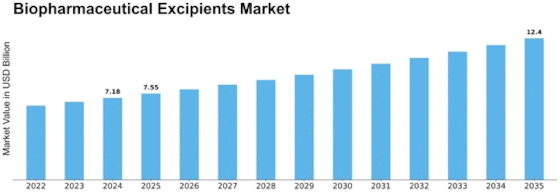

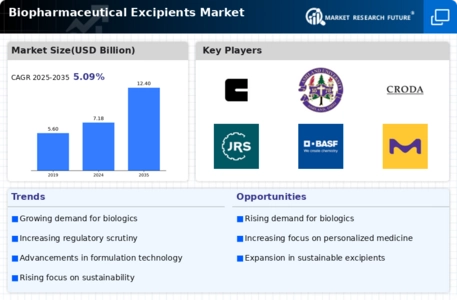
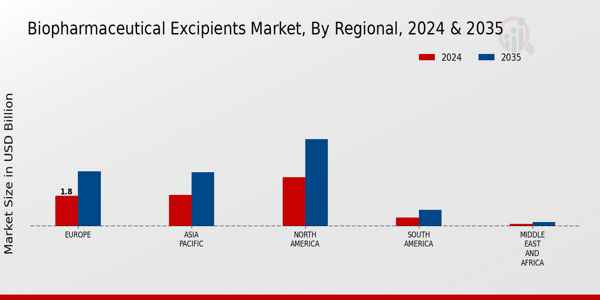




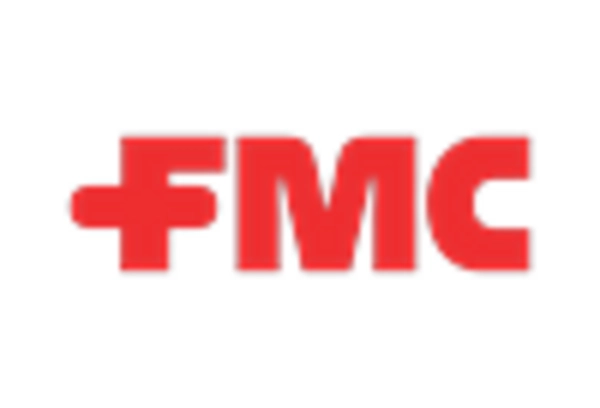
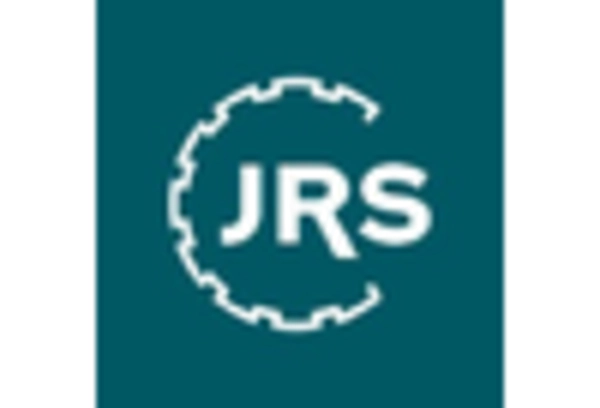

Leave a Comment